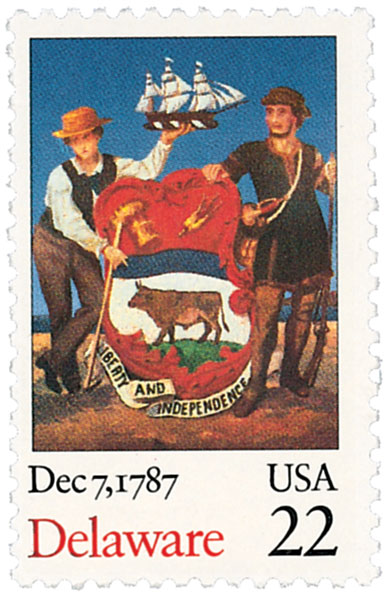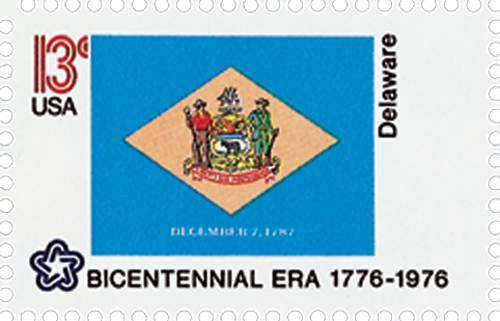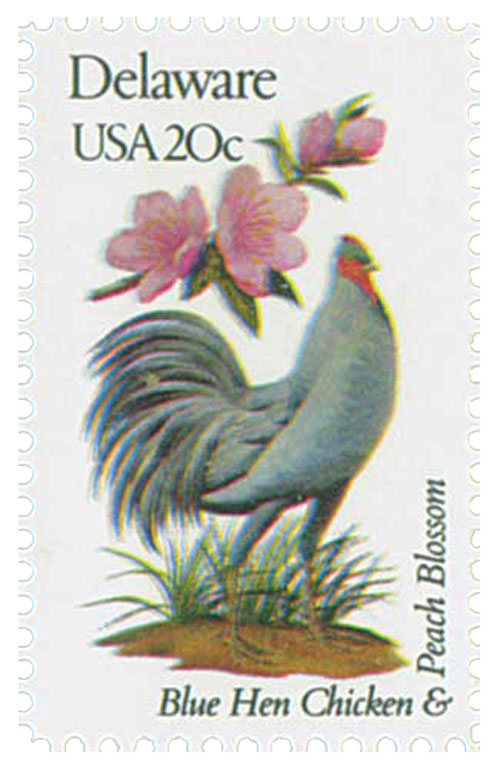
# 3568 FDC - 2002 34c Greetings From America: Delaware
Delaware
34¢ Greetings From America
City: New York, NY
Quantity: 200,000,000
Printed by: American Packaging Corp for Sennett Security Products
Printing Method: Photogravure
Perforations: Serpentine Die Cut 10.75
Quantity: 200,000,000
Delaware Becomes America’s First State

On December 7, 1787, Delaware was the first state to ratify the U.S. Constitution, making it America’s first state.
Two Algonquian Indian tribes lived in the Delaware region when the first European explorers arrived. The Lenni-Lenape tribe lived along the Delaware River. The Nanticoke lived along the Nanticoke River. By the mid-1700s, white settlers had pushed most of the American Indians out of Delaware.
The English explorer Henry Hudson was the first European to visit the Delaware area. In 1609, he sailed into Delaware Bay looking for a trade route to the Far East. When Hudson saw the bay led to a river, he left the region and continued his search farther north. In 1610, Captain Samuel Argall of the Virginia Colony took refuge in the Delaware Bay during a fierce storm. He named the bay De La Warr Bay, after Lord De La Warr, Virginia’s governor.
The Dutch attempted to create a settlement in the region at Zwaanendael (present-day Lewes) in 1631, but within a year, Indians massacred the settlers and burned their fort. In 1638, Swedish settlers came to the region and founded the colony of New Sweden. They built Fort Christina, the first permanent white settlement, at the present-day site of Wilmington. The colony quickly expanded northward as new colonists arrived from Sweden and Finland. However, the Dutch believed New Sweden fell within their territory, and in 1651, the governor of the Dutch colony of New Netherland, Peter Stuyvesant, established Fort Casimir at the site of present-day New Castle. The Swedes captured Fort Casimir in 1654, but the following year the Dutch took control of New Sweden.

The British captured all of New Netherland in 1664. Delaware was made part of the colony of New York. In 1682, a year after William Penn founded Pennsylvania, it was made part of that colony. Delaware became known as the Three Lower Counties, because it was “down” the Delaware River from Pennsylvania. As Pennsylvania grew, Delaware asked Penn to grant them a separate legislature, which he did in 1704. However, Pennsylvania governors ruled Delaware until the American Revolutionary War.

Representatives from the Three Lower Counties attended the First Continental Congress in Philadelphia in 1774. At the Second Continental Congress on July 2, 1776, the Three Lower Counties voted for independence. Later that year, the Three Lower Counties became Delaware State and established a state constitution. New Castle became the state’s first capital.
Troops from Delaware fought throughout the Revolutionary War. But only one small battle was fought in the state, when outnumbered American troops attempted to stop the British from marching toward Philadelphia, Pennsylvania. The troops met the British at Coochs Bridge, near Newark, on September 3, 1777, but were quickly forced to retreat. The British marched on the defeated forces of General George Washington at the Battle of Brandywine. The British occupied Wilmington on September 12, 1777, forcing the legislature to move away from nearby New Castle. The legislature moved several times before making Dover the capital. Dover remains Delaware’s capital city to this day.
Delaware
34¢ Greetings From America
City: New York, NY
Quantity: 200,000,000
Printed by: American Packaging Corp for Sennett Security Products
Printing Method: Photogravure
Perforations: Serpentine Die Cut 10.75
Quantity: 200,000,000
Delaware Becomes America’s First State

On December 7, 1787, Delaware was the first state to ratify the U.S. Constitution, making it America’s first state.
Two Algonquian Indian tribes lived in the Delaware region when the first European explorers arrived. The Lenni-Lenape tribe lived along the Delaware River. The Nanticoke lived along the Nanticoke River. By the mid-1700s, white settlers had pushed most of the American Indians out of Delaware.
The English explorer Henry Hudson was the first European to visit the Delaware area. In 1609, he sailed into Delaware Bay looking for a trade route to the Far East. When Hudson saw the bay led to a river, he left the region and continued his search farther north. In 1610, Captain Samuel Argall of the Virginia Colony took refuge in the Delaware Bay during a fierce storm. He named the bay De La Warr Bay, after Lord De La Warr, Virginia’s governor.
The Dutch attempted to create a settlement in the region at Zwaanendael (present-day Lewes) in 1631, but within a year, Indians massacred the settlers and burned their fort. In 1638, Swedish settlers came to the region and founded the colony of New Sweden. They built Fort Christina, the first permanent white settlement, at the present-day site of Wilmington. The colony quickly expanded northward as new colonists arrived from Sweden and Finland. However, the Dutch believed New Sweden fell within their territory, and in 1651, the governor of the Dutch colony of New Netherland, Peter Stuyvesant, established Fort Casimir at the site of present-day New Castle. The Swedes captured Fort Casimir in 1654, but the following year the Dutch took control of New Sweden.

The British captured all of New Netherland in 1664. Delaware was made part of the colony of New York. In 1682, a year after William Penn founded Pennsylvania, it was made part of that colony. Delaware became known as the Three Lower Counties, because it was “down” the Delaware River from Pennsylvania. As Pennsylvania grew, Delaware asked Penn to grant them a separate legislature, which he did in 1704. However, Pennsylvania governors ruled Delaware until the American Revolutionary War.

Representatives from the Three Lower Counties attended the First Continental Congress in Philadelphia in 1774. At the Second Continental Congress on July 2, 1776, the Three Lower Counties voted for independence. Later that year, the Three Lower Counties became Delaware State and established a state constitution. New Castle became the state’s first capital.
Troops from Delaware fought throughout the Revolutionary War. But only one small battle was fought in the state, when outnumbered American troops attempted to stop the British from marching toward Philadelphia, Pennsylvania. The troops met the British at Coochs Bridge, near Newark, on September 3, 1777, but were quickly forced to retreat. The British marched on the defeated forces of General George Washington at the Battle of Brandywine. The British occupied Wilmington on September 12, 1777, forcing the legislature to move away from nearby New Castle. The legislature moved several times before making Dover the capital. Dover remains Delaware’s capital city to this day.













